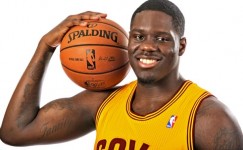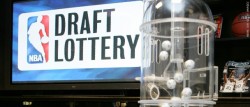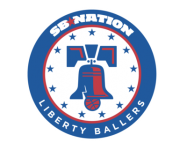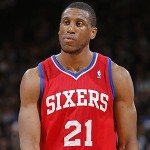
Yesterday afternoon, Brian Windhorst was on ESPN Radio in New York saying that the Kevin Love to Cleveland trade is agreed upon in principle, with the huge caveat that something could happen sometime between now and August 23rd, when it can finally become official. Still, the news that the two sides have seemingly come to an agreement on compensation for Love was big news.
Windhorst then went on to speculate about the Sixers involvement in the trade. It’s worth listening to the audio (linked above, starting at around the 9:45 mark), but it seemed as if Windhorst’s tone shifted from reporting fact (Cleveland & Minnesota have an agreement in principle) to speculation when talking about the Sixers. Sean O’Connor over at LibertyBallers did a good job of transcribing the audio.
“But before the papers have been signed, there’s this handshake agreement that: Kevin Love to the Cavs, Andrew Wiggins to the Timberwolves, and I believe Thaddeus Young will end up in Minnesota, either as part of a separate deal or as part of a three-way deal, possibly Anthony Bennett who’s on the Cavs right now could get re-routed to Philadelphia in part of a deal for Thaddeus Young. There will be draft picks involved, but essentially what you need to know if you’re an NBA fan: Kevin Love will end up in Cleveland barring anything unforeseen, and Andrew Wiggins will end up in Minnesota.”
— Brian Windhorst, ESPN Radio New York
As mentioned, “I believe” and “possibly” are two words that make it seem like he’s less certain on Philadelphia’s involvement then he is on the Cleveland/Minnesota portion being agreed upon.
It’s also worth noting, that while many are reporting that the Sixers could get a draft pick back in the trade, and while that’s certainly a possibility, Windhorst doesn’t specifically say that there will be a pick coming back to Philadelphia, just that picks will be involved in the trade. Still, for a breakdown of potential picks that the Sixers could receive, check out the article I wrote last week on the subject.
Still, despite the fact that the Sixers portion of it came off as speculation, with how connected Windhorst is to the deal, combined with Marc Stein’s report last week that the Wolves are specifically targeting Thaddeus Young, along with the report that the Sixers would have accepted Anthony Bennett in the Jrue Holiday/Nerlens Noel trade last summer, Windhorst’s report that the Sixers could end up with Anthony Bennett is certainly newsworthy, and worth a closer look.
(Note: Last fall I was part of a group that sat down with Sam Hinkie for an extended Q&A session over breakfast, and he addressed the rumors that they would have taken Bennett in the trade. His response was that he never would have said that, because revealing a draft board is “the shortest of the short games,” specifically because players become available later in their careers. Interesting that now, just 10 months after that breakfast, he’s on the verge of acquiring one of those rumored players).
Why the wait?
We’re in this holding period because Cleveland signed Andrew Wiggins to a contract on July 24th. Because of this, Cleveland has to wait at least 30 days before Andrew Wiggins can be included in a trade.
Why would they sign Andrew Wiggins and delay the completion of the trade, when it has seemed like this was inevitable since the time they signed LeBron? The answer could be for salary matching purposes. Kevin Love is set to earn $15.7 million this upcoming season, and because Cleveland is now over the cap, they have to get close to sending out that much salary in return. Before Wiggins signed his contract, his outbound salary counted as $0 in trade calculations. Now that he has signed his contract, when he is traded he will count at (a presumed) $5.5 million in the trade. If the Cavaliers made this trade before signing Wiggins, they would have had to have found another player(s) to add to make up that difference.
Why are the Sixers involved?
One thing to make clear, it is not necessary for the Sixers to be involved in this trade. Non-taxpaying teams (which the Cavs are) only have to get their outbound salary within $5 million of what they are receiving (on trades where their outgoing salary totals between $9.8 million and $19.6 million). Wiggins’ and Bennett’s salaries total roughly $11.09 million, which falls into this range is within $5 million of Kevin Love’s salary ($16.07 million).
That being said, the Sixers could be involved for either of two reasons.
One reason is that either the Wolves of the Cavs could look to dump an unwanted contract on the Sixers, such as Kevin Martin (3 years, $21 million remaining). The purpose of the Sixers would mainly be to take back salary on a player who would be an unnecessary luxury on a rebuilding team like the Wolves. However, reports are starting to suggest that Flip Saunders and Minnesota may want Martin around for the rebuild. If so, the necessity to include the Sixers as a 3rd team lessens dramatically.
Even without that, the Sixers are being linked to the trade because of Minnesota’s specific interest in acquiring Thaddeus Young. No longer are the Sixers mentioned as a suitor just because they have cap space, but because they have a specific asset that Minnesota is looking for.
Now, why Minnesota would be targeting Young I’m not so sure. From a basketball standpoint, it makes perfect sense, as Young is only 25 years old and is an incredibly valuable basketball player, and one who should still be valuable 3-4 years down the line when the Wolves (hopefully) are through the hard part of their rebuild and regaining relevancy. However, with the reports that Young has been displeased with the Sixers rebuild, I can’t envision him being happy going through the same process in Minnesota. Since Young possesses an early termination option after this season, it seems odd that Minnesota is specifically targeting a one year rental.
Anthony Bennett the draft prospect
When looking at Anthony Bennett, it’s hard to really get a gauge on his value. On the one hand, he’s barely over 13 months removed from being the top pick in the draft. On the other hand, he just came off arguably the worst rookie season for a #1 overall pick in the modern era.
While Bennett going #1 was a surprise to me, I still had him rated at #4 on my own personal draft board heading into the draft.
Measurables:
As Bennett was nursing a shoulder injury, he did not participate at the 2013 NBA combine, so the last public measurement we have for him is the 2012 Nike Hoop Summit. He measured 6’7″ in shoes there, weighing 239 pounds and with a 7’1″ wingspan. He is listed at 6’8″ and 259 lbs on his nba.com player profile.
While at 6”7″ in shoes, Bennett would certainly be undersized, his 7’1″ wingspan would be slightly above average for a power forward, and also above average for a player of his size. Unfortunately, for a post player the measurement I’m more interested in is standing reach, and because of his injury last year we don’t have good data on that. That being said, I would classify him as an undersized power forward, but one with long enough arms to help him overcome that.
Stats at UNLV
A quick look at some stats from while Bennett was at UNLV.
Year | GP | MPG | PPG | RPG | APG | SPG | BPG |
|---|---|---|---|---|---|---|---|
| Out of Conference | 19 | 29.4 | 19.5 | 8.9 | 1.2 | 0.8 | 1.3 |
| In Conference | 16 | 24.4 | 12.1 | 7.2 | 0.7 | 0.5 | 1.1 |
| 2012-13 UNLV (all) | 35 | 27.1 | 16.1 | 8.1 | 1.0 | 0.7 | 1.2 |
Year | ORtg | DRtg | USG% | PER | Win Shares | WS/40 | OWS | DWS |
|---|---|---|---|---|---|---|---|---|
| 2012-13 UNLV (conference) | 99.6 | 90.2 | 26.9% | 20.4 | 1.4 | 0.146 | 0.5 | 0.9 |
| 2012-13 UNLV (all) | 117.6 | 89.3 | 27.5% | 28.3 | 5.7 | 0.240 | 3.5 | 2.3 |
Year | OReb% | DReb% | blk% | stl% | ft rate | 2pt% | 3pta-3ptm | 3pt% |
|---|---|---|---|---|---|---|---|---|
| 2012-13 UNLV (conference) | 10.7% | 20.8% | 4.7% | 1.2% | ? | 53% | 13-37 | 35.1% |
| 2012-13 UNLV (all) | 10.3% | 21.8% | 4.6% | 1.5% | 46.7% | 58.7% | 36-96 | 37.5% |
The immediate takeaway is: man, did Anthony Bennett feast on a relatively weak non-conference schedule, which according to Kenpom.com was ranked 180th toughest in the country, including teams such as Chicago St (ranked 287th per Kenpom, where Bennett scored 22 points on 7-11 shooting), Cal St. Bakersfield (ranked 241st, 28 points on 10-13 shooting), Northern Arizona (ranked 294th, 22 points on 9-13 shooting), Jacksonville St (ranked 206th, 12 points on 3-6 shooting), Hawaii (ranked 213th, 16 points on 6-12 shooting), and Portland (ranked 262nd, 18 points on 6-11 shooting).
All teams have cupcakes on their schedule, of course. But the combination of UNLV’s relatively weak out of conference schedule and his pretty big in conference / out of conference splits inflated Bennett’s overall stats just a bit.
Still, Bennett’s in-conference play (against a relatively strong Mountain West Conference) provided quite a bit of optimism, averaging 12.1 points, 7.2 rebounds in only 24 minutes per game, yielding a 20.4 PER and 0.146 win shares per 40 minutes (remember, WS/40 is used in college, whereas if you’re used to the NBA stat, it’s WS/48. Adjust accordingly). He had the highest PER (28.3) of any freshman player drafted that season (second highest was Nerlens Noel at 27.3).
Skills shown at UNLV
What made Bennett so intriguing of a prospect was high combination of strength, athleticism, and versatile offensive game, which, combined with his good length, allowed him to overcome his short height.
Bennett got a high percentage of offense in the post, where his strength, footwork, and ability to make moves over either shoulder made him a real threat, and was a solid projectable skill for him at the next level. Combining that with his accurate outside shot (37.5% from three on nearly 3 attempts per game), which included being able to hit shots off the dribble at an extremely impressive rate considering his size, and he was a tough cover. All of this then opened up a dribble drive game where he once again showcased that surprising athleticism and how comfortable he was handling the basketball with either hand, and he had an incredibly diverse skill set for a big man. For as much as the NBA has become about the stretch power forward, Bennett could theoretically fill that role, while still providing a considerable threat scoring in the paint off of legitimate post-up skills, dribble drives, and offensive rebounds. He brought potentially the best of both worlds.
His biggest pitfall, besides potential weight concerns, was on the defensive side of the court. A glass-half-full kind of person would say “his effort level was inconsistent.” I’m not sure I’d agree with that. His effort level was fairly consistent, it was just consistently bad. From effort, to positioning, to stance and technique, Bennett could best be described as a disinterested defender. He can hopefully be hidden somewhat next to Nerlens Noel and (eventually) Joel Embiid, but Brett Brown will have his hands full trying to get him to contribute (outside of rebounding, which he’s very good at) on this side of the court.
For more information, go check out our DraftExpress scouting report from before the draft.
His rookie season
Then came his rookie season. Again, a glass-half-full type would call it a struggle. A glass-half-empty type would call it possibly the worst rookie season for a #1 overall pick in 30+ years.
Last year for the Cavs, Bennett 4.2 points per in just over 12.8 minutes per game, shooting 35.6% from the field. He generate -0.4 win shares on the season (-0.028/48), including -1.1 offensive win shares, with a true shooting percentage of 42.5% and a PER of 6.9.
No #1 overall pick has done worse in ANY of win shares, offensive win shares, PER, or true shooting percentage. Here are some of the closest “competitors” to Anthony Bennett’s rookie season:
Player | Season | Minutes | PER | Win Shares | Offensive Win Shares | TS% |
|---|---|---|---|---|---|---|
| Anthony Bennett | 2013-14 | 663 | 6.9 | -0.4 | -1.1 | 42.5% |
| Kwame Brown | 2001-02 | 817 | 11.2 | 0.8 | 0.0 | 45.0% |
| Kenyon Martin | 2000-01 | 2272 | 13.4 | 2.1 | -0.4 | 47.2% |
| Michael Olowokandi | 1998-99 | 1279 | 11.8 | -0.3 | -0.8 | 44.5% |
| Pervis Ellison | 1989-90 | 866 | 10.3 | 0.4 | -0.5 | 47.5% |
| Danny Manning | 1988-89 | 950 | 13.4 | 0.7 | 0.0 | 53.8% |
| Mark Aguirre | 1981-82 | 1468 | 17.3 | 1.9 | 1.0 | 51.4% |
The outliers on this list of Kenyon Martin and Danny Manning, who went on to have strong careers, although with Martin’s value being based off of his defense (a clear weakness of Bennett’s) and with Manning being far more of a perimeter player, drawing any parallel with these two would be difficult. And none of these seasons really even approached Bennett’s level of ineptitude in any of the aforementioned stats.
To be fair, Bennett did show signs of life at the end of the season, averaging 7.2 points and 4.8 rebounds on a 51.9% true shooting percentage in February, before missing quite a bit of time at the end of the season with a left patellar tendon strain. But, by all accounts his rookie season was an abject failure.
Why?
The why is, of course, as important as the what in this instance, mostly out of the hope that it could be corrected. Injuries and conditioning played a very big role in his disappointing rookie season, with his conditioning sapping him of his quickness and explosiveness, two staples of his game.
Right before the draft, DraftExpress was reporting that his conditioning had seemingly sent his stock into a tailspin. Well, one out of two isn’t bad. His stock, obviously, couldn’t have gone higher, with the Cavaliers shocking virtually everybody by taking him #1. The conditioning, however, turned out to be a huge problem.
His conditioning wasn’t helped by a shoulder injury he had suffered over the summer, which left him behind on a lot of his training. Nor was it helped by asthma and sleep apnea, conditions which were revealed last fall. But that’s no excuse to show up like he did last season, where he looked like a pale imitation of his former self athletically.
Perhaps more concerning than his conditioning (which itself is a huge concern) was his effort level. He simply looked disinterested, on both ends of the court, most of the times that I saw him. Maybe that was the Cavaliers situation, maybe that was his own situation, but combined with his disinterest on the defensive end at UNLV, there’s some concern there.
Finally, his jump shot, which seemed like a staple of his game at UNLV, failed him. Bennett shot only 24.5% fro three point range and 27.7% from between 16′ and the three point line, both far off what he did during his one year in college. To make matters worse, his shot selection seemed to deteriorate from where it was in college, with 28.9% of his field goal attempts coming from between 16′ and the 3 pt line, and 23.6% coming from three point range, combining to represent over 52% of his field goal attempts. Bennett became enamored with a shot he simply wasn’t hitting.
To his credit, he did look worlds better in the summer league, from a conditioning and athletic standpoint. He reportedly lost 20 pounds heading into the summer league, he moved well, and had much of that explosiveness that he had at UNLV back.
This would be Brett Brown’s biggest test, both from testing his conditioning program and his ability to keep a player engaged. This isn’t Royce White, whom the Sixers were seemingly ready to move on from the moment they acquired him, seeing White as the price to obtain Furkan Aldemir. This is an exceptionally talented kid at a premium position, only 13 months removed from being the #1 overall pick. There’s some rewards to be had if they can keep him in shape and keep him engaged on the court.
Risk diversification
“The draft is a crapshoot.” You hear it all the time. And yes, it’s true, there is considerable risk in the draft (although not as much as people make it out to be). So why is Sam Hinkie acquiring so many picks?
Risk diversification. If you’re in the stock market, the riskiest thing to do is to put all of your eggs in one basket. The NBA draft is the same. Joel Embiid is a great prospect. Nerlens Noel has elite defensive potential. Anthony Bennett has an incredibly unique offensive game. But any of them could turn out to be busts, whether it’s due to injury, an inability to translate, an inability to stay in shape, or any of the three. The best way to win the odds is to stockpile lottery balls, not only for that drawing in May but also in the form of talented prospects.
The Sixers are set to have 5 lottery picks in 3 years, while potentially acquiring a player only 13 months removed from being the top pick in the draft. Risk diversification.
This move also falls in line with the Sixers strategy of pouncing on undervalued assets. Anthony Bennett may never become the prospect some saw before the draft, but his shoulder injury, and the impact that had on his conditioning, made his rookie year worse than it might have otherwise been, and significantly lowered his value to the point where the Sixers might be able to grab him for a player who isn’t in their long term plans.
The salary situation
What is Anthony Bennett’s salary situation? He has just over $5.5 million guaranteed to him for this season. The next two seasons are team options, and the Sixers would have to pick up his 2015-16 option (for $5.8 million) by the end of October. While the Sixers were in a similar situation with Royce White last season, Bennett is far more talented, and with the way he showed up in shape for the summer league, I would peg it at a virtually 0% chance that they don’t pick up his 3rd year option.
Is he worth Thad?
In terms of potential, he absolutely has more potential than Thad.
However, with the conditioning concerns, his defensive indifference, and his horrid rookie season, if you held a gun to my head and asked me which player would be more valuable over the next 5 seasons, I’d say Thaddeus Young. Bennett has the potential to be a 2a offensive option, but Thad, to me, is a far safer bet. If I’m being asked probable contributions, I think Thad is higher, and we have to remember Thad is only 25 as well.
But, there are three things in Bennett’s favor:
- Salary. While 120% of last years rookie salary is a big figure, he’s cost controlled for 3 more years. Thad has one year left at $9.4 million, then an early termination option, which he’s almost certain to trigger. He’ll likely be looking for a long term deal at a much higher annual salary.
- Desire to be here. There have been rumors for over a year that Thad doesn’t want to go through a rebuild. Bennett, on the other hand, is likely more worried about playing time and opportunity, which he’d have plenty of here.
- Youth. Bennett just turned 21 this past March.
Truth be told, if I felt confident that Thaddeus Young would be here long term, as I’ve said, I’m more confident that he will be a contributor over the next 5 years than Anthony Bennett. However, since Thad is likely gone after this next season, Anthony Bennett simply has far too much offensive talent to pass up, and would be a great haul for a soon to be former Sixer.



